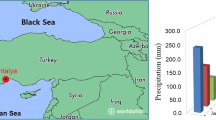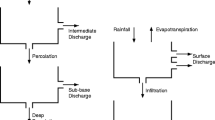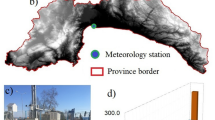Abstract
It is well documented that standalone machine learning methods are not suitable for rainfall forecasting in long lead-time horizons. The task is more difficult in arid and semiarid regions. Addressing these issues, the present paper introduces a hybrid machine learning model, namely multiple genetic programming (MGP), that improves the predictive accuracy of the standalone genetic programming (GP) technique when used for 1-month ahead rainfall forecasting. The new model uses a multi-step evolutionary search algorithm in which high-performance rain-borne genes from a multigene GP solution are recombined through a classic GP engine. The model is demonstrated using rainfall measurements from two meteorology stations in Lake Urmia Basin, Iran. The efficiency of the MGP was cross-validated against the benchmark models, namely standard GP and autoregressive state-space. The results indicated that the MGP statistically outperforms the benchmarks at both rain gauge stations. It may reduce the absolute and relative errors by approximately up to 15% and 40%, respectively. This significant improvement over standalone GP together with the explicit structure of the MGP model endorse its application for 1-month ahead rainfall forecasting in practice.








Similar content being viewed by others
References
Aksoy, H., & Dahamsheh, A. (2009). Artificial neural network models for forecasting monthly precipitation in Jordan. Stochastic Environmental Research and Risk Assessment, 23(7), 917–931.
Aksoy, H., & Dahamsheh, A. (2018). Markov chain-incorporated and synthetic data-supported conditional artificial neural network models for forecasting monthly precipitation in arid regions. Journal of Hydrology, 562, 758–779.
Azad, A., Manoochehri, M., Kashi, H., Farzin, S., Karami, H., Nourani, V., & Shiri, J. (2019). Comparative evaluation of intelligent algorithms to improve adaptive neuro-fuzzy inference system performance in precipitation modelling. Journal of Hydrology, 571, 214–224.
Bakhshaii, A., & Stull, R. (2009). Deterministic ensemble forecasts using gene-expression programming. Weather and Forecasting, 24(5), 1431–1451.
Cassel, D. K., Wendroth, O., & Nielsen, D. R. (2000). Assessing spatial variability in an agricultural experiment station field: opportunities arising from spatial dependence. Agronomy Journal, 92(4), 706–714.
Danandeh Mehr, A. (2018). An improved gene expression programming model for streamflow forecasting in intermittent streams. Journal of Hydrology, 563, 669–678.
Danandeh Mehr, A., & Kahya, E. (2017). A Pareto-optimal moving average multigene genetic programming model for daily streamflow prediction. Journal of Hydrology, 549, 603–615.
Danandeh Mehr, A., Nourani, V., Hrnjica, B., & Molajou, A. (2017). A binary genetic programing model for teleconnection identification between global sea surface temperature and local maximum monthly rainfall events. Journal of Hydrology, 555, 397–406.
Danandeh Mehr, A., Nourani, V., Karimi Khosrowshahi, V., & Ghorbani, M. A. (2018a). A hybrid support vector regression–firefly model for monthly rainfall forecasting. International journal of Environmental Science and Technology, 1-12, 643–667.
Danandeh Mehr, A., Nourani, V., Kahya, E., Hrnjica, B., Sattar, A. M., & Yaseen, Z. M. (2018b). Genetic programming in water resources engineering: a state-of-the-art review. Journal of Hydrology, 566.
Delleur, J. W., & Kavvas, M. L. (1978). Stochastic models for monthly rainfall forecasting and synthetic generation. Journal of Applied Meteorology, 17(10), 1528–1536.
Dufek, A. S., Augusto, D. A., Dias, P. L., & Barbosa, H. J. (2017). Application of evolutionary computation on ensemble forecast of quantitative precipitation. Computers & Geosciences, 106, 139–149.
Eray, O., Mert, C., & Kisi, O. (2018). Comparison of multi-gene genetic programming and dynamic evolving neural-fuzzy inference system in modeling pan evaporation. Hydrology Research, 49(4), 1221–1233.
Fallah-Ghalhüry, G. A., Mousavi-Baygi, M., & Nokhandan, M. H. (2009). Annual rainfnail forecasting by using Mamdani fuzzy inference system. Research Journal of Environmental Sciences, 3(4), 400–413.
Farajzadeh, J., & Alizadeh, F. (2018). A hybrid linear–nonlinear approach to predict the monthly rainfall over the Urmia Lake watershed using wavelet-SARIMAX-LSSVM conjugated model. Journal of Hydroinformatics, 20(1), 246–262.
Feng, Q., Wen, X., & Li, J. (2015). Wavelet analysis-support vector machine coupled models for monthly rainfall forecasting in arid regions. Water Resources Management, 29(4), 1049–1065.
Hinchliffe, M., Hiden, H., McKay, B., Willis, M., Tham, M., & Barton, G. (1996). Modelling chemical process systems using a multi-gene. Late breaking papers at the genetic programming. pp 56–65.
Hossain, I., Rasel, H. M., Imteaz, M. A., & Mekanik, F. (2018). Long-term seasonal rainfall forecasting: efficiency of linear modelling technique. Environmental Earth Sciences, 77(7), 280.
Hrnjica, B., & Danandeh Mehr, A. (2019). Optimized genetic programming applications: emerging research and opportunities (pp. 1–310). Hershey: IGI global.
Jia, X., Shao, M., Zhu, Y., & Luo, Y. (2017). Soil moisture decline due to afforestation across the Loess Plateau, China. Journal of Hydrology, 546, 113–122.
Karamouz, M., Razavi, S., & Araghinejad, S. (2008). Long-lead seasonal rainfall forecasting using time-delay recurrent neural networks: a case study. Hydrological Processes: An International Journal, 22(2), 229–241.
Karimi, B., Safari, M., Danandeh Mehr, A., & Mohammadi, M. (2019). Monthly rainfall prediction using ARIMA and gene expression programming: a case study in Urmia, Iran. Online Journal of Engineering Sciences and Technologies, 2(3), 8–17.
Kashid, S. S., & Maity, R. (2012). Prediction of monthly rainfall on homogeneous monsoon regions of India based on large scale circulation patterns using genetic programming. Journal of Hydrology, 454, 26–41.
Kisi, O., & Cimen, M. (2012). Precipitation forecasting by using wavelet-support vector machine conjunction model. Engineering Applications of Artificial Intelligence, 25(4), 783–792.
Kisi, O., & Shiri, J. (2011). Precipitation forecasting using wavelet-genetic programming and wavelet-neuro-fuzzy conjunction models. Water Resources Management, 25(13), 3135–3152.
Koza, J. R., (1992). The genetic programming paradigm: genetically breeding populations of computer programs to solve problems. Dynamic, Genetic, and Chaotic Programming, (June), 203–321. A.
Lin, G. F., & Chen, L. H. (2005). Application of an artificial neural network to typhoon rainfall forecasting. Hydrological Processes, 19(9), 1825–1837.
Lin, G. F., & Wu, M. C. (2009). A hybrid neural network model for typhoon-rainfall forecasting. Journal of Hydrology, 375(3–4), 450–458.
Luk, K. C., Ball, J. E., & Sharma, A. (2000). A study of optimal model lag and spatial inputs to artificial neural network for rainfall forecasting. Journal of Hydrology, 227(1–4), 56–65.
Mehr, A. D., Jabarnejad, M., & Nourani, V. (2019). Pareto-optimal MPSA-MGGP: a new gene-annealing model for monthly rainfall forecasting. Journal of Hydrology, 571, 406–415.
Mekanik, F., Imteaz, M. A., & Talei, A. (2016). Seasonal rainfall forecasting by adaptive network-based fuzzy inference system (ANFIS) using large scale climate signals. Climate Dynamics, 46(9–10), 3097–3111.
Nasseri, M., Asghari, K., & Abedini, M. J. (2008). Optimized scenario for rainfall forecasting using genetic algorithm coupled with artificial neural network. Expert Systems with Applications, 35(3), 1415–1421.
Samantaray, S., Tripathy, O., Sahoo, A., & Ghose, D. K. (2020). Rainfall forecasting through ANN and SVM in Bolangir Watershed, India. In smart intelligent computing and applications (pp. 767–774). Singapore: Springer.
Searson, D. (2015). GPTIPS 2: aan open-source software platform for symbolic data mining. In A. H. G. et al. (Ed.), Chapter 22 in handbook of genetic programming applications. New York, NY: Springer.
Sivapragasam, C., Liong, S., & Pasha, M. (2001). Rainfall and runoff forecasting with SSA-SVM approach. Journal of Hydroinformatics, 3(3), 141–152.
Toth, E., Brath, A., & Montanari, A. (2000). Comparison of short-term rainfall prediction models for real-time flood forecasting. Journal of Hydrology, 239, 132–147.
Wu, C. L., Chau, K. W., & Fan, C. (2010). Prediction of rainfall time series using modular artificial neural networks coupled with data-pre-processing techniques. Journal of Hydrology, 389(1–2), 146–167.
Yevjevich, V. (1987). Stochastic models in hydrology. Stochastic Hydrology and Hydraulics, 1(1), 17–36.
Zhu, C., & Wu, J. (2013). Hybrid of genetic algorithm and simulated annealing for support vector regression optimization in rainfall forecasting. International Journal of Computational Intelligence and Applications, 12(02), 1350012.
Author information
Authors and Affiliations
Corresponding author
Additional information
Publisher’s note
Springer Nature remains neutral with regard to jurisdictional claims in published maps and institutional affiliations.
Rights and permissions
About this article
Cite this article
Danandeh Mehr, A., Safari, M.J.S. Multiple genetic programming: a new approach to improve genetic-based month ahead rainfall forecasts. Environ Monit Assess 192, 25 (2020). https://doi.org/10.1007/s10661-019-7991-1
Received:
Accepted:
Published:
DOI: https://doi.org/10.1007/s10661-019-7991-1




